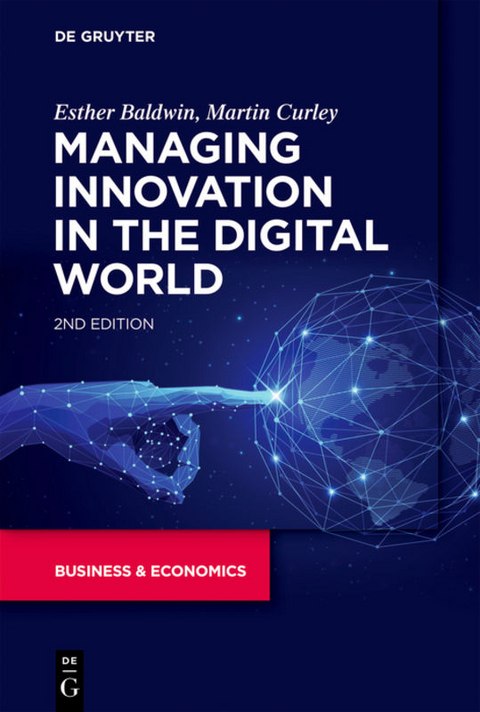
Managing Innovation in the Digital World
De|G Press (Verlag)
978-1-5015-1578-1 (ISBN)
- Noch nicht erschienen
- Versandkostenfrei
- Auch auf Rechnung
- Artikel merken
Esther Baldwin, Intel, USA; Martin Curley, National University of Ireland, Maynooth
1 Introduction 1
The Importance of Innovation 2 Innovation's Virtuous Circle 3
Three Types of Innovation 4 Radical Innovation 4
Incremental Innovation 5 Innovation by Reapplication 5
Innovation Need Not be Wholescale Invention 5 Innovation is Not Just About Products and Services 7
Investment in Innovation 7
Value Creation Opportunities 9
Open Innovation and the Drive for Best End Value 10 Innovation Shifts in Business Models 12
IT Innovation: A Two-Part Process 12 Creation 12
Adoption and Diffusion 13 Innovation as a Lateral Process 16
Barriers to Innovation 17
In This Book ... 17 S
Summary 19
Business Value Management 21
The Importance of a Common Language 22 The Cost of Miscommunication 23 Business Value Dials 25
Business Value and IT Efficiency 27 Building Innovation Business Cases 29
IT Innovation Business Cases 29
Portfolio Management 31
Post-Implementation Review 32
Summary 32
IT Innovation 33
The Special Case of IT Innovation 34
The Six Parallel Vectors of IT Innovation 35 Vision 36
From Vision to Prototype 38 Business Case 40
Business Process Change 42 Organizational Change 42 Customer or Societal Change 43
Summary 47
Systemic Innovation 49
Managing Systemic Innovation 50 Systemic Innovation 52
Capability Maturity Framework for Systemic Innovation 54 Ad Hoc 54
IT Innovation CMF Basic Level of Maturity 55
IT Innovation CMF Intermediate Level of Maturity 55 IT Innovation CMF Advanced Level of Maturity 58 IT Innovation CMF Optimizing Level of Maturity 60
Innovation Excellence and Operations Excellence 64 Systemic Innovation Imperatives 64
Summary 65
Innovation Capability 67
IT Innovation Project Stages 68 Ideate 69
Brainstorming 69
Lateral Thinking 69
TRIZ 71
Ethnographic Research 71
Prototype 73
Concept Cars 73
Usage Models 74
User-Centered Design 74
Refine 75
Outsource 76
Open Source 76 Software as a Service 76 Open Innovation 77
Diffuse 77
Web 2.0 Internet 77
Mashups 79
Crowd Sourcing 79
Copy-Exactly 80
Other Diffusion Techniques 80 Summary 81
Innovation Assessment 83
Intel's Innovation Self-Assessment Process 84 Assessment Teams 84
The Assessment Process 84
The Self-Assessment Framework 85
Section 1. Management Commitment 86
Section 2. Business Responsibility 88
Section 3. Innovation Competency 89
Section 4. Enterprise Values 90
Section 5. Innovation Support 92
Section 6. Impact of Innovation 92 Scoring the Self Assessment 93 Developing an Action Plan 96 Moving to the Next Maturity Level 98
Management Commitment 99
Business Responsibility 101
Innovation Competency 103
Enterprise Values 105
Innovation Support 106 Impact of IT Innovation 108
The Importance of Innovation Assessment 110 Summary 111
Innovation Pipeline Management 113
The IT Innovation Pipeline 114 Pipeline Stages 115 Pipeline Value Paths 116
Managing the IT Innovation Pipeline 117 Step 1: Design the Pipeline 118
Step 2: Capture Innovation Ideas 120
Step 3: Create and Populate a Registration System 121 Step 4: Choose a Vetting Procedure 122
Step 5: Manage the Innovation Project Portfolio 123 Step 6: Establish and Use Value Realization Metrics 125
Improving Yield for IT Innovations 126 Tactics for Improving Yield 127 Sample Results 127
Intel Innovation Index 128 Summary 129
Diffusion of IT Innovation 131
Diffusion Fundamentals: How Innovations are Adopted 132
Categories of Adopters 132 The Chasm 133
Chasm Two 134
The S-curve Perspective 135 Metcalfe's Law 137 Gladwell's Tipping Point 138 Friedman's Flat World 139
Diffusion Fundamentals: Lessons Learned 140 Diffusion of IT Innovation 141
Assets, Methods, Skillsets 142
Develop Infrastructure 142
Prepare Technical Support 144 Marketing Innovations 145
One Final Ingredient for Success 147 Summary 147
Launching Systemic IT Innovation 149
Gaining Management Commitment 150 Create and Communicate a Vision 150 Develop an Innovation Strategy 151 Measure Business Value 152
Developing Innovation Capabilities 153 Training 153
Reinforcing Innovation 154
Innovation Centers 155 Creation and Diffusion 156 Intel's Experience 158
Innovation Enablers and Inhibitors 158 Systemic Innovation 159
Culture and Innovation 160
Summary 160
Stay in touch 161
Appendix A Case Studies in IT Innovation 163
Wireless Westminster, Part 1 164
Vision 164
The Prototype 165
The Business Case 167 Wireless Westminster, Part 2 169
Business Process Changes 169
Organizational Changes 170 Societal and Customer Changes 170 Vision Revisited 170
Epilogue 171
Innovative eSupport at Intel, Part 1 172 A Vision is Born 173
Formalizing the Effort 173 Calling for the Question 174
Innovative eSupport at Intel, Part 2 175
Appendix B Innovation Assessment Tools 179
Intel's Self-Assessment Tool 180
Section 1. Management Commitment 180
Section 2. Business Responsibility 182
Section 3. Innovation Competency 184
Section 4. Enterprise Values 185
Section 5. Innovation Support 189
Section 6. Impact of Innovation 190 Appraising Innovation Performance 191
References 193
Index 199
| Erscheinungsdatum | 29.06.2017 |
|---|---|
| Zusatzinfo | 15 Tables, black and white; 4 Illustrations, black and white |
| Verlagsort | Boston |
| Sprache | englisch |
| Maße | 155 x 230 mm |
| Themenwelt | Naturwissenschaften ► Biologie ► Ökologie / Naturschutz |
| Technik ► Architektur | |
| Wirtschaft ► Betriebswirtschaft / Management ► Unternehmensführung / Management | |
| Schlagworte | Innovation, IT, User centered design, Invention, R • Innovation, IT, User centered design, Invention, Re-engineer, innitiatives, Innovator, Corporate culture, Intel |
| ISBN-10 | 1-5015-1578-0 / 1501515780 |
| ISBN-13 | 978-1-5015-1578-1 / 9781501515781 |
| Zustand | Neuware |
| Informationen gemäß Produktsicherheitsverordnung (GPSR) | |
| Haben Sie eine Frage zum Produkt? |
aus dem Bereich


